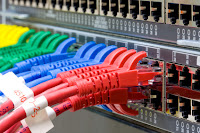Monday, April 1, 2013
The most common DICOM connectivity problems.
 The most common DICOM connectivity errors are related to addressing issues and/or a mismatching of the negotiated capabilities. Addressing issues can be categorized as follows:
The most common DICOM connectivity errors are related to addressing issues and/or a mismatching of the negotiated capabilities. Addressing issues can be categorized as follows:- IP address issues − The IP address might be incorrectly configured, or DHCP has created a new IP address different from the one that is used in the configuration file. one of the quirks with DICOM connections is its reliance on fixed IP addresses, which shows that it was defined in the early 1990’s, prior to the popularity of dynamic IP addressing. Any router can be configured to assign a fixed IP address, but IT maintenance or replacement of the router without reconfiguring can assign a new IP address to a host, which causes the fixed IP settings in the DICOM devices to be incorrect. Using the ping feature will allow a simple check of the availability and configuration of the IP address.
- Net mask or domain incorrect − Although the IP address can be correctly configured, if the domain or net mask settings do not match between the source and destination, there will be no communication. Checking the settings at both the destination and source will show if there are any discrepancies.
- Port number incorrect − The initial port number that was commonly used was port 104, however this caused problems in some devices that did not allow low numbers to be assigned. The correct port number to be used instead is 11112, which is officially assigned to DICOM by the Internet Assigned Numbers Authority (IANA). Mismatching port numbers will show up in a sniffer log as multiple “SYN/ACK” sequences that cannot be resolved.
- AE Title Incorrect − Note that AE-Titles are case-sensitive, which is probably the most common error made. Mismatching AE-title errors can easily be identified by a sniffer or DICOM error log as it is a standard status code.
- Firewalls − Many computers and routers have firewalls configured. Make sure that the applicable ports are open.
The DICOM Association has always negotiated between devices using a specific presentation context which consists of an abstract syntax and one or more transfer syntaxes. An example of an abstract syntax is the CT Image Storage SOP Class. An example of a transfer syntax might be JPEG compression. If a proposed presentation context does not match the capabilities at the destination, the message that comes back will indicate a complete or partial rejection of the association. Examples of new SOP Classes that might not be supported are Dose structured reports (SR) from a CT, comprehensive structured reports containing measurements from an ultrasound, CAD results, or new image SOP Classes such as the enhanced CT, MR or digital mammography or tomosynthesis images.
These errors are easy to simulate by using a modality simulator that has the capability of sending exactly the same presentation contexts and investigating the log files and sniffer logs. The resolution is for the destination to be upgraded to support the new SOP classes or having a service engineer simply adding this to the configuration. Another option is to “downgrade” the SOP classes at the source, for example, instead of a CAD result or ultrasound measurement in a SR, send the information in a screen capture, or send the images in the “old” format.
New transfer syntaxes, which are often lacking, are MPEG for video clips, and new wavelet compression techniques. The solution is also upgrading the destination or downgrading the source.
In conclusion, with the right tools, it is relatively easy to visualize the reason why a DICOM connection cannot be made. A visual presentation on using the tools and how the data would look is available on YouTube, see link.
'메모' 카테고리의 다른 글
| 차등수가제, 차등지수...펌 (0) | 2014.03.31 |
|---|---|
| Configure and use DICOM network services, ae title, ip, port...펌 (0) | 2014.03.30 |
| dicom 용어집, called AE, calling AE...펌 (0) | 2014.03.29 |
| 고스트 복원후 윈도우 부팅이 안될때...펌 (0) | 2014.03.27 |
| 톰캣, 아파치에서 자바 작동케하는 APM서버...펌 (0) | 2014.03.23 |